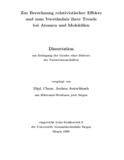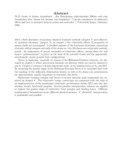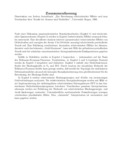Citation link:
https://nbn-resolving.org/urn:nbn:de:hbz:467-1427| DC Field | Value | Language |
|---|---|---|
| dc.contributor.author | Autschbach, Jochen | - |
| dc.date.accessioned | 2019-09-02T09:54:48Z | - |
| dc.date.available | 2006-10-18T12:12:12Z | - |
| dc.date.available | 2019-09-02T09:54:48Z | - |
| dc.date.issued | 1999 | - |
| dc.description.abstract | Nach einer Diskussion quantenchemischer Standardmethoden (Kapitel 1) und relativistischer Quantenchemie (Kapitel 2) werden in Kapitel 3 relativistische Effekte atomarer Schalen untersucht. Eine detaillierte Analyse relativer (prozentualer) relativistischer Effekte von Orbitalradien und -energien der Atome 1 bis 118 deckt neuartige relativistische perriodische Trends auf. Eine Erklärung verschiedener Anomalien relativistischer Effekte bei Atomen, darunter auch das bekannte "Gold-Maximum", kann mit Hilfe der gefundenen periodischen Trends und der scheinbar unsystematischen Atomgrundzustands-Konfigurationen gegeben werden. Kräfte in Molekülen werden in Kapitel 4 besprochen - insbesondere auf der Basis des Hellmann-Feynman-Theorems. Verschiedene, in Kapitel 5 und 6 benötigte Formeln werden in Kapitel 4 hergeleitet und diskutiert. Kapitel 5 enthält eine Dichtefunktional-Studie der Bindungskräfte in N2 und HCl. Durch Analyse der räumlichen Herkunft der Hellmann-Feynman-Kräfte kann gezeigt werden, daß sowohl die Topologie der molekularen Deformationsdichte als auch die kernnahe Rumpfpolarisierung etwa gleichbedeutend für die Berechnung der Bindungs-Kräfte sind. In Kapitel 6 werden relativistische Bindungsenergien und -Kräfte von zweiatomigen Goldverbindungen analysiert. Die relativistischen Energieänderungen werden mit Hilfe einer Implementierung der nichtsingulären relativistischen Störungstheorie DPT in das Amsterdamer Dichtefunktionalprogramm berechnet. Verschiedene paradoxe Interpretationsschemata werden zur Erklärung der Herkunft von relativistischen Bindungsenergie- und -kraft-Änderungen verwendet. Unterschiedliche mathematische Formulierungen erzeugen verschiedene physikalische Bilder. Eine "chemische" Interpretation ist vorzuziehen und kann gegeben werden. | de |
| dc.description.abstract | After a brief discussion of quantum chemical standard methods (chapter 1) and relativistic quantum chemistry (chapter 2), in chapter 3 the relativistic effects of properties of atomic shells are investigated. A detailed analysis of the fractional relativistic corrections of atomic orbital energies and radii of the atoms no. 1 to 118 shows new relativistic periodic trends. An explanation of several anomalies of relativistic effects, among them the well known "gold-maximum", is given on the basis of the periodic trends and the appearently unsystematic atomic ground state configurations. Forces in molecules, especially by means of the Hellmann-Feynman theorem, are discussed in chapter 4, where also several formulae are derived, which are used in chapters 5 and 6. Chapter 5 contains a density-functional study of the binding forces in N2 and HCl. By analyzing the spatial origin of the Hellmann-Feynman forces it is concluded that both the topology of the molecular deformation density as well as the sharp core polarizations are approximately equally important to determine the forces. Relativistic bonding energies and forces of several diatomic gold compounds are analyzed in chapter 6. The relativistic energy corrections are computed with the help of an implementation of the nonsingular relativistic perturbation theory DPT into the Amsterdam density functional program. Several paradox interpretation schemes are applied to explain the spatial origin of relativistic bond energies and binding forces. Different mathematical formulations create different physical pictures. A "chemical" interpretation is preferrable and possible. | en |
| dc.identifier.uri | https://dspace.ub.uni-siegen.de/handle/ubsi/142 | - |
| dc.identifier.urn | urn:nbn:de:hbz:467-1427 | - |
| dc.language.iso | de | de |
| dc.rights.uri | https://dspace.ub.uni-siegen.de/static/license.txt | de |
| dc.subject.ddc | 540 Chemie | de |
| dc.subject.other | Quantenchemie | de |
| dc.subject.other | Theoretische Chemie | de |
| dc.subject.other | Relativistik | de |
| dc.title | Zur Berechnung relativistischer Effekte und zum Verständnis ihrer Trends bei Atomen und Molekülen | de |
| dc.type | Doctoral Thesis | de |
| item.fulltext | With Fulltext | - |
| ubsi.date.accepted | 1999-05-16 | - |
| ubsi.publication.affiliation | Fachbereich 8, Chemie - Biologie | de |
| ubsi.subject.ghbs | UTS | - |
| ubsi.type.version | publishedVersion | de |
| Appears in Collections: | Hochschulschriften | |
Files in This Item:
| File | Description | Size | Format | |
|---|---|---|---|---|
| autschbach.pdf | 4.09 MB | Adobe PDF |  View/Open | |
| abstract.pdf | 23.5 kB | Adobe PDF |  View/Open | |
| abst_ger.pdf | 25.18 kB | Adobe PDF |  View/Open |
This item is protected by original copyright |
Page view(s)
561
checked on Dec 3, 2024
Download(s)
998
checked on Dec 3, 2024
Google ScholarTM
Check
Items in DSpace are protected by copyright, with all rights reserved, unless otherwise indicated.

